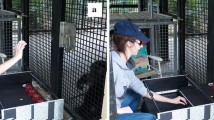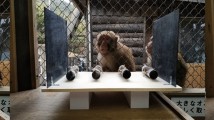Abstract
Metacognition refers to the ability to monitor and control one’s own cognitive activities such as memory. Although recent studies have raised an interesting possibility that some species of nonhuman animals might possess such skills, subjects often required a numerous number of training trials to acquire the effective use of metacognitive responses. Here, five orangutans (Pongo pygmaeus) were tested whether they were able to escape spatial memory tests when they did not remember the location of preferred reward in a relatively small number of trials. The apes were presented with two identical cups, under one of which the experimenter hid a preferred reward (e.g., two grapes). The subjects were then presented with a third container, “escape response”, with which they could receive a less preferred but secure reward (e.g., one grape). The orangutans as a group significantly more likely selected the escape response when the baiting of the preferred reward was invisible (as compared to when it was visible) and when the hiding locations of the preferred reward were switched (as compared to when they remained unchanged). Even when the escape response was presented before the final presentation of the memory test, one orangutan successfully avoided the test in which she would likely err. These findings indicate that some orangutans appear to tell when they do not remember correct answers in memory tests.





Similar content being viewed by others
References
Barth J, Call J (2006) Tracking the displacement of objects: a series of tasks with great apes (Pan troglodytes, Pan paniscus, Gorilla gorilla, and Pongo pygmaeus) and young children (Homo sapiens). J Exp Psychol Anim Behav Proc 32:239–252
Beran MJ (2002) Maintenance of self-imposed delay of gratification by four chimpanzees (Pan troglodytes) and an orangutan (Pongo pygmaeus). J Gen Psychol 129:49–66
Beran MJ, Pate JL, Rumbaugh DM (1999) Delay of gratification in chimpanzees (Pan troglodytes). Dev Psychol 34:119–127
Beran MJ, Smith JD, Redford JS, Washburn DA (2006) Rhesus macaques (Macaca mulatta) monitor uncertainty during numerosity judgments. J Exp Psychol Anim Behav Proc 32:111–119
Bräuer J, Call J, Tomasello M (2004) Visual perspective-taking in dogs (Canis familiaris) in the presence of barriers. Appl Anim Behav Sci 88:299–317
Call (2001) Object permanence in orangutans (Pongo pygmaeus), chimpanzees (Pan troglodytes), and children (Homo sapiens). J Comp Psychol 115:159–171
Call (2003) Spatial rotations and transpositions in orangutans (Pongo pygmaeus) and chimpanzee (Pan troglodytes). Primates 44:347–357
Call J (2005) The self and other: a missing link in comparative social cognition. In: Terrace HS, Metcalfe J (eds) The missing link in cognition: origins of self-reflective consciousness. Oxford University Press, New York, pp 321–341
Call J, Carpenter M (2001) Do apes and children know what they have seen?. Anim Cogn 4:207–220
de Blois ST, Novak MA, Bond M (1998) Object permanence in orangutans (Pongo pygmaeus) and squirrel monkeys (Saimiri sciureus). J Comp Psychol 112:137–152
de Blois ST, Novak MA, Bond M (1999) Can memory requirements account for species’ differences in invisible displacement tasks?. J Exp Psychol Anim Behav Proc 25:168–176
Hampton RR (2001) Rhesus monkeys know when they remember. Proc Natl Acad Sci 98:5359–5362
Hampton RR, Zivin A, Murray EA (2004) Rhesus monkeys (Macaca mulatta) discriminate between knowing and not knowing and collect information as needed before acting. Anim Cogn 7:239–246
Hare B, Call J, Tomasello M (2001) Do chimpanzees know what conspecifics know?. Anim Behav 61:139–151
Hare B, Call J, Agnetta B, Tomasello M (2000) Chimpanzees know what conspecifics do and do not see. Anim Behav 59:771–785
Inman A, Shettleworth SJ (1999) Detecting metamemory in nonverbal subjects: a test with pigeons. J Exp Psychol Anim Behav Proc 25:389–395
Kaminski J, Call J, masello M (2004) Body orientation and face orientation: two factors controlling apes’ begging behavior from humans. Anim Cogn 7:216–223
Kornell N, Son LK, Terrace HS (2007) Transfer of metacognitive skills and hint seeking in monkeys. Psychol Sci 18:64–71
MacDonald SE, Agnes MM (1999) Orangutan (Pongo pygmaeus abelii) spatial memory and behavior in a foraging task. J Comp Psychol 113:213–217
Melis AP, Call J, Tomasello M (2006) Chimpanzees conceal visual and auditory information from others. J Comp Psychol 120:154–162
Nelson TO, Narens L (1990) Metamemory: a theoretical framework and new findings. In: Bower GH (ed) The psychology of learning and motivation, vol. 26. Academic Press, New York, pp 125–141
Nelson TO, Narens L (1994) Why investigate metacognition? In: Metcalfe J, Shimamura AP (eds) Metacognition: knowing about knowing. MIT Press, Cambridge, pp 1–25
Paukner A, Anderson JR, Fujita K (2006) Redundant food searches by capuchin monkeys (Cebus apella): a failure of metacognition? Anim Cogn 9:110–117
Sabiaul F, Romansky K, Cantlon JF, Klein T, Terrace H (in press) Cognitive imitation in 2-year-old human children (Homo sapience): a comparison with rhesus monkeys (Macaca mulatta). Anim Cogn. doi:10.1007/s10071-006-0070-3
Shields WE, Smith JD, Guttmannova K, Washburn DA (2005) Confidence judgments by humans and rhesus monkeys. J Gen Psychol 132:165–186
Shields WE, Smith JD, Washburn DA (1997) Uncertain responses by humans and rhesus monkeys (Macaca mulatta) in a psychophysical same-different task. J Exp Psychol Gen 126:147–164
Shillito DJ, Shumaker RW, Gallup GG, Beck BB (2005) Understanding visual barriers: evidence for level 1 perspective taking in an orang-utan, Pongo pygmaeus. Anim Behav 69:679–687
Shumaker RW and Swartz KB (2004) Cognition: mirror self-recognition. In: Bekoff M (ed) Encyclopedia of Animal Behavior, Vol. 1, A-C. Greenwood Press, Westport CT London, pp 308–312
Smith JD, Schull J, Strote J, McGee K, Egnor R, Erb L (1995) The uncertain response in the bottlenosed dolphin (Tursiops truncatus). J Exp Psychol Gen 124:391–408
Smith JD, Shields WE, Allendoerfer KR, Washburn DA (1998) Memory monitoring by animals and humans. J Exp Psychol Gen 127:227–250
Smith JD, Shields WE, Schull J, Washburn DA (1997) The uncertain response in humans and animals. Cognition 62:75–97
Smith JD, Shields WE, Washburn DA (2003a) The comparative psychology of uncertainty monitoring and metacognition. Behav Brain Sci 26:317–339
Smith JD, Shields WE, Washburn DA (2003b) Inaugurating a new area of comparative cognition research. Behav Brain Sci 26:358–373
Son LK, Kornell N (2005) Metaconfidence judgments in rhesus macaques: explicit versus implicit mechanisms. In: Terrace HS, Metcalfe J (eds) The missing link in cognition: origins of self-reflective consciousness. Oxford University Press, New York, pp 296–320
Swartz KB, Himmanen SA (2006) Individual response strategies in list learning by orangutans. Int J Psychol Psychol Therapy 6:233–248
Tomasello M, Hare B, Agnetta B (1999) Chimapnzees, Pan troglodytes, follow gaze direction geometrically. Anim Behav 58:769–777
Washburn DA, Smith JD, Shields WE (2006) Rhesus monkeys (Macaca mulatta) immediately generalize the uncertain response. J Exp Psychol Anim Behav Proc 32:185–189
Acknowledgments
I thank Lisa Stevens for allowing me to work with the great apes at the Smithsonian National Zoological Park and the zookeepers of the Great Ape House for their support. I also thank Milton Tierney for constructing the testing apparatus. This study was supported by a research grant from the David Bohnett Foundation. All of the experiments complied with the current laws of the country in which they were conducted.
Author information
Authors and Affiliations
Corresponding author
Rights and permissions
About this article
Cite this article
Suda-King, C. Do orangutans (Pongo pygmaeus) know when they do not remember?. Anim Cogn 11, 21–42 (2008). https://doi.org/10.1007/s10071-007-0082-7
Received:
Revised:
Accepted:
Published:
Issue Date:
DOI: https://doi.org/10.1007/s10071-007-0082-7




